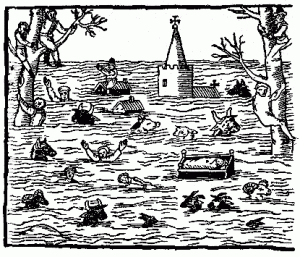
Woodcut of a 1607 flood in E. Anglia
A.D. 1014 This year on the eve of St. Michael’s Day, came the great sea-flood, which spread wide over this land, and ran so far up as it never did before, overwhelming many towns, and an innumerable multitude of people. THE ANGLO-SAXON CHRONICLE
The date of this event in 1014 was 28 September. The wave described by the Anglo-Saxon Chronicle swept through the English Channel, impacting England’s southern coast as well as areas of what is now the Netherlands. But the wave also moved northward along the coasts of Cornwall and Wales, rounded the northern coast of Scotland and then continued south along England’s eastern coast. We do not know if this disaster took place in the daytime or at night. We only know that it was sudden, and that those affected never saw it coming.
What could have caused such a great sea-flood? We tend to link tsunamis with earthquakes, but there is no record of any earthquake in September, 1014. We tend to associate flooding with storms, but the annals make no mention of a storm
M. Baillie, in an article published in the Journal of Quarternary Science, 2007, speculates that the 1014 tsunami recorded by chroniclers in Britain and at Quedlinburg Abbey in Saxony was caused by a meteor that landed in the North Atlantic.
In the 11th century there was no Red Cross. There was no FEMA. Who cared for those left homeless? Who buried the bodies of the dead? How long did it take for the devastated towns and villages to recover, and is it possible that some might never have recovered? Might they have simply been washed away and, eventually, forgotten?
We can only guess at the answers to those questions as we stand in awe of Mother Nature’s fury even now, one thousand years later.